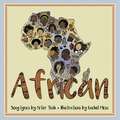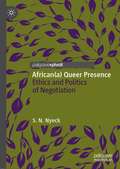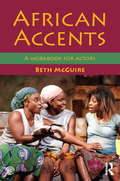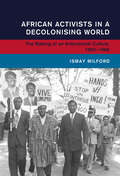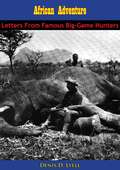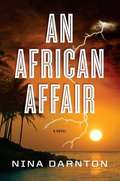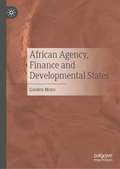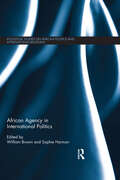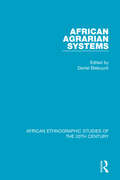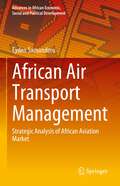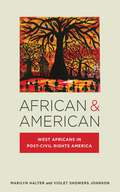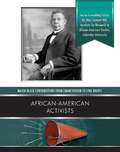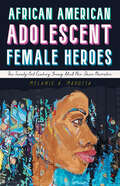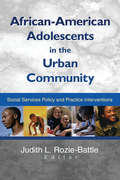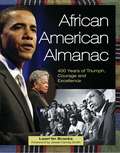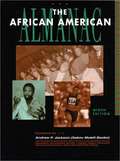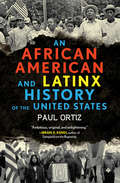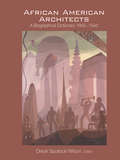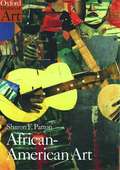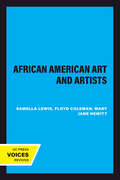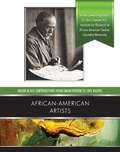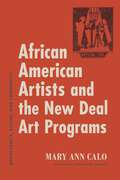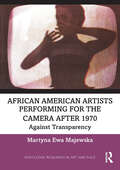- Table View
- List View
African: A Children's Picture Book (LyricPop #0)
by Peter ToshAn AALBC Recommended New Book! Included in Publishers Weekly's Children's Galleys to Grab at Winter Institute! A beautiful children's picture book featuring the lyrics of Peter Tosh's global classic celebrating children of African descent. So don't care where you come from As long as you're a black man, you're an African No mind your nationality You have got the identity of an African African is a children's book featuring lyrics by Peter Tosh and illustrations by Jamaican artist Rachel Moss. The song "African" by Peter Tosh was originally released in 1977 on his second solo record, Equal Rights. He wrote the song during a time of civil unrest in Jamaica as a reminder to all black people that they were part of the same community. The album is considered one of the most influential reggae works of all time. A key song from the classic 1970s era of reggae Peter Tosh was one of the founding members of the iconic reggae group the Wailers
African(a) Queer Presence: Ethics and Politics of Negotiation
by S.N. NyeckTo achieve something by way of negation is not just to state a difference. It is to impose a certain kind of violence and domination on things so ordered around for the sake of epistemic, religious, or political expediency also. The notion of queerness presented in this book takes the view that the process of conceptualizing selves “out-of-order” is fundamentally anti-dialectical, negotiated, political and spiritual. Queerness negation manifested as a form of colonial and postcolonial epistemic and political violence defines reality as the clash of ideal and non-ideal categories. The demand to achieve something by way of negation that dialectics imposes on itself is costly because it treats negation as inevitable. From an anti-dialectical standpoint, analyses of the films Proteus and Karmen Geï deal with the processes of freeing queer selves from colonial and postcolonial negation. The book reflects on the conditions and possibilities of queerness affirmation as an ethics of presence grounded in the politics of negotiation following the proposition of nego-feminism and the practical humanism of Senghor to offer an ethical and embodied vision of an ecological depth of feeling and will as foundational to relational possibilities within the African(a) world.
African Accents: A Workbook for Actors
by Beth McGuireThis is a comprehensive workbook for actors, covering the key characteristics and profiles of a wide range of African accents of English. Its unique approach not only addresses the methods and processes by which to go about learning an accent, but also looks in detail at each example. This lets the reader plot their own route through the learning process and tailor not only their working methods but also their own personal idiolect. Full breakdowns of each accent cover: an introduction giving a brief history of the accent, its ethnic background, and its language of origin preparatory warm-up exercises specific to each accent a directory of research materials including documentaries, plays, films and online resources key characteristics such as melody, stress, pace and pitch descriptions of physical articulation in the tongue, lips, jaw, palate and pharynx practice sentences, phoneme tables and worksheets for solo study. African Accents is accompanied by a website at www.routledge.com/cw/mcguire with an extensive online database of audio samples for each accent. The book and audio resources guide actors to develop their own authentic accents, rather than simply to mimic native speakers. This process allows the actor to personalize an accent, and to integrate it into the creation of character rather than to play the accent on top of character.
African Activists in a Decolonising World: The Making of an Anticolonial Culture, 1952–1966 (Global and International History)
by Ismay MilfordAs wars of liberation in Africa and Asia shook the post-war world, a cohort of activists from East and Central Africa, specifically the region encompassing present-day Malawi, Zambia, Uganda and mainland Tanzania, asked what role they could play in the global anticolonial landscape. Through the perspective of these activists, Ismay Milford presents a social and intellectual history of decolonisation and anticolonialism in the 1950s and 1960s. Drawing on multi-archival research, she brings together their trajectories for the first time, reconstructing the anticolonial culture that underpinned their journeys to Delhi, Cairo, London, Accra and beyond. Forming committees and publishing pamphlets, these activists worked with pan-African and Afro-Asian solidarity projects, Cold War student internationals, spiritual internationalists and diverse pressure groups. Milford argues that a focus on their everyday labour and knowledge production highlights certain limits of transnational and international activism, opening up a critical – albeit less heroic – perspective on the global history of anticolonial work and thought.
African Adventure: Letters From Famous Big-Game Hunters (Peter Capstick's Library)
by Denis D. LyellTHIS small volume contains some of the letters I have received during the last thirty years or more from well-known big-game hunters and field-naturalists, many of whom have now passed away.They were so interesting to me that I thought they might interest others who have shot in wilder Africa. Moreover, they describe conditions which are no longer possible considering the way many parts of that continent have been opened up since the Great War.Whether the spread of a so-called civilization is a good thing I do not wish to discuss, but I know there are many men, including myself, who would prefer the older times when things were less complicated and conventional.Many people are now going in for photography more than shooting, and in a way this is a good thing as it will naturally help to conserve the game. It is, however, a much less risky amusement to take animals' pictures--I mean dangerous animals--than to try to kill them, for game such as lion, elephant, buffalo, leopard and rhinoceros are seldom dangerous until they are wounded and followed up in thick cover. Some people may doubt this statement, but it is nevertheless true, as all experienced hunters can vouch.
An African Affair
by Nina Darnton“A vivid portrait of a troubled country. ” —The New York Times Corruption, drug smuggling, rampant human rights abuses—New York journalist Lindsay Cameron finds plenty to report, covering the regime of Nigeria’s President Michael Olumide. But in the aftermath of two probable assassinations, her inquiries attract unwanted government attention. As rebel factions call for free elections, Lindsay races to penetrate the intricate network of corrupt government officials, oil interests, and CIA agents who really run the Nigerian show. Meanwhile, her entanglement with a rare art dealer leads her still deeper into terrain that’s confounding in every respect – from matters of the heart to those of politics and trade. Drawing from Nina Darnton’s own experiences living in Africa during the mid-1970s—including imprisonment in Nigeria with her two small children—An African Affair is an edge-of-your-seat debut thriller in the bestselling tradition of The Constant Gardener and The Last King of Scotland. .
African Agency, Finance and Developmental States
by Gorden MoyoThis book is an open invitation to the enterprise of re-imagining an alternative decolonial development project in Africa. It does this by focusing on the triple themes of African agency, development finance, and African developmental states in the context of an emerging multipolar world system. The book must be read as an affirmatively disruptive inquiry into the twin evils of global coloniality and global capitalist economic relations that have kept Africa on the lower rungs of the global pecking order, thereby preventing the rooting of an alternative development paradigm on the continent. As such, the book seeks to contribute towards the project of extricating the financing of development in Africa from the clutches of the Global North and the emerging powers of the Global South. In this way, it is a call for Afro-rebellion against the old and new forms of global coloniality and global capitalism. While the book is of major interest to scholars and students of African Studies, Development Studies, International Development Cooperation, International Relations, International Trade and Investment, Diplomacy, Africa–China Relations, and Political Science, it is equally meant for the general reader as it assumes no prior knowledge in any of the field of enquiry other than interest in the development of the African continent.
African Agency in International Politics (Routledge Studies in African Politics and International Relations)
by William Brown Sophie HarmanThis book analyses the rapidly increasing role of African states, leaders and other political actors in international politics in the 21st Century. In contrast to the conventional approach of studying how external actors impacted on Africa’s international relations, this book seeks to open up a new approach, focusing on the impact of African political actors on international politics. It does this by analysing African agency – the degree to which African political actors have room to manoeuvre within the international system and exert influence internationally, and the uses they make of that room for manoeuvre. Bringing together leading scholars from Africa and Europe to explore the role and conception of African Agency, this book addresses a wide range of issues, from relations with western and non-western donors, Africa’s role in the UN and World Trade Organisation, negotiations over climate change, trade agreements with the European Union, regional diplomatic strategies, the character and extent of African state agency, and agency within corporate social responsibility initiatives. African Agency in International Politics will be of interest to scholars and students of Africa’s international relations, African politics, development, geography, diplomacy, trade, the environment, political science and security studies.
African Agrarian Philosophy (The International Library of Environmental, Agricultural and Food Ethics #35)
by Mbih Jerome Tosam Erasmus MasiteraThis book critically explores indigenous sub-Saharan African agrarian thought. Indigenous African agrarian philosophy is an uncharted and largely overlooked area of study in the burgeoning fields of African philosophy and philosophy of nature. The book shows that wherever human beings have lived, they have been preoccupied with exploring ways to ensure the sustainable management of limited resources at their disposal, to attain to their basic needs: food, shelter, and security. The book also shows that agriculture and the way people relate with nature are an essential, but generally neglected, determinant of the emergence and orientation of all philosophical traditions. In traditional, pre-colonial African culture, it was difficult to separate agriculture from African relational ontology. Agriculture and the use of natural resources were at the centre of community life and influenced the social, political, economic, and spiritual worldviews of the people. In their contact with nature through agriculture, different beliefs, knowledge systems, norms, moral outlooks, cultural practices and institutions emerged and have been valorized to guide societies on how to sustainably manage the environment. As a way of life, then, agriculture was deeply connected with indigenous beliefs, values, and practices which transcended a wide range of issues related to ecological ethics, food ethics, religion, traditional medicine, political economy, social organisation, biological reproduction and species survival, indigenous knowledge, and property rights. This book will thus be a valuable resource for policy makers and researchers in diverse fields such as philosophy, geography, sociology, anthropology, and development studies.
African Agrarian Systems
by Daniel BiebuyckOriginally published in 1963 this volume surveys various aspects of the complex relations between rights in land, social organization and economic interests in tropical Africa. The papers - in English and French but with summaries in the other language - analyse case studies illustrating the various basic factors and problems connected with land in Tropical Africa. Indigenous systems of tenure and their adaptation to commercial agriculture, the balance between rights and obligations of groups and individuals, and the authority and duties of chiefs and headmen are discussed in detail for many different areas. Against this background important contributions are made towards the better understanding of problems raised by economic and political development, population increase, migration and scarcity of land.
African Air Transport Management: Strategic Analysis of African Aviation Market (Advances in African Economic, Social and Political Development)
by Eyden SamunderuThis book provides a comprehensive overview of the African air transport market from a strategic management perspective. Drawing on well-grounded theories, research applications and real-world case studies, it examines competition dynamics, interconnectivity, the growth of low-cost carriers, and demand patterns in air transport for both passenger and cargo traffic. It also presents an expert analysis on the introduction of the Single African Air Transport Market (SAATM), made possible by the liberalization of the air transport market, from a regulatory perspective. Based on the results of the analysis, the book evaluates both the benefits and limitations of an open skies agreement. Furthermore, it shed lights on the challenges and complexities of African public infrastructure investments and airport financing, discusses the impact of COVID-19, and provides strategic recommendations for airlines. The book is aimed at professionals in aviation and airline industries and students interested in the African air transport market.
African & American: West Africans in Post-Civil Rights America (Nation of Nations #24)
by Marilyn Halter Violet Showers JohnsonExamines what it means to be African and American through the stories of recent West African immigrantsAfrican & American tells the story of the much overlooked experience of first and second generation West Africanimmigrants and refugees in the United States during the last forty years. Interrogating the complex role of post-colonialism in the recent history of black America, Marilyn Halter and Violet Showers Johnson highlight the intricate patterns of emigrant work and family adaptation, the evolving global ties with Africa and Europe, and the translocal connections among the West African enclaves in the United States.Drawing on a rich variety of sources, including original interviews, personal narratives, cultural and historical analysis, and documentary and demographic evidence, African & American explores issues of cultural identity formation and socioeconomic incorporation among this new West African diaspora. Bringing the experiences of those of recent African ancestry from the periphery to the center of current debates in the fields of immigration, ethnic, and African American studies, Halter and Johnson examine the impact this community has had on the changing meaning of “African Americanness” and address the provocative question of whether West African immigrants are, indeed, becoming the newest African Americans.
African American Activists (Major Black Contributions from Emancipat)
by Carol EllisThe Civil War finally ended slavery in the United States in 1865. But blacks didn't suddenly enjoy all the rights other Americans took for granted. They had to struggle against racism and discrimination to claim those rights. African-American Activists traces that generations-long struggle. In this book, you'll meet early activists like Booker T. Washington and W. E. B. Du Bois, who had very different ideas about how blacks should take their place in American society. You'll read about activists who worked for integration and equality under the law during the civil rights movement, including Rosa Parks and John Lewis. And you'll learn how a new generation of African-American activists, such as Majora Carter and Van Jones, continue to work for a better society today.
African American Adolescent Female Heroes: The Twenty-First-Century Young Adult Neo-Slave Narrative (Children's Literature Association Series)
by Melanie A. MarottaIn the wake of the second wave of the Black Lives Matter movement, inequalities and disparities were brought to light across the publishing industry. The need for more diverse, representative young adult literature gained new traction, resulting in an influx of young adult speculative fiction featuring African American young women. While the #BlackGirlMagic movement inspired a wave of positive African American female heroes in young adult fiction, it is still important to acknowledge the history and legacy of enslavement in America and their impact on literature. Many of the depictions of young Black women in contemporary speculative fiction still rely on stereotypical representations rooted in American enslavement.African American Adolescent Female Heroes: The Twenty-First-Century Young Adult Neo-Slave Narrative investigates the application of the neo-slave narrative structure to the twenty-first-century young adult text. Author Melanie A. Marotta examines texts featuring a female, adolescent protagonist of color, including Orleans, Tankborn, The Book of Phoenix, Binti, and The Black God’s Drums, as well as series like the Devil’s Wake series, Octavia E. Butler’s Parable series, and the Dread Nation series. Taken together, these chapters seek to analyze whether the roles for adolescent female characters of color are changing or whether they remain re-creations of traditional slave narrative roles. Further, the chapters explore if trauma, healing, and activism are enacted in this genre.
African-American Adolescents in the Urban Community: Social Services Policy and Practice Interventions
by Judith Rozie-BattleBecome a more effective social worker with this outstanding volume on inner-city urban youth! African-American Adolescents in the Urban Community: Social Services Policy and Practice Interventions examines contemporary issues confronting African-American youth. It highlights key areas such as health, education, the criminal justice system, and youth development strategies. An essential overview of the status of urban African-American youth for students, professionals working with this important population, and policymakers, this vital book proposes policy and programming considerations for today and for the future.African-American Adolescents in the Urban Community is a one-stop view of: ways to help African-American youth experience responsibility and community involvement health concerns of this population, including teen pregnancy, alcohol and drug addiction, and limited access to health care the challenges that lie ahead for African-American girls, including crime, poverty, poor self-esteem, and peer pressure ways to help teenage fathers meet their financial and emotional obligations to their families police and prosecutorial policies that need to be examined and challenged to end the perception of a racially unjust system and much more
African-American/Afro-Canadian Schooling
by Charles L. GlennTracing the history of black schooling in North America, this book emphasizes factors in society at large - and sometimes within black communities - which led to black children being separate from the white majority. In African-American/Afro-Canadian Schooling: From the Colonial Period to the Present , Charles L. Glenn reveals the evolution of assumptions about race and culture as applied to schooling, as well as the reactions of black parents and leadership in the United States and Canada.
African American Almanac
by Jessie Carney Smith Lean'Tin BracksThe most complete and affordable singlevolume reference of African American culture available today, this almanac is a unique and valuable resource devoted to illustrating and demystifying the moving, difficult, and often lost history of black life in America. A legacy of pride, struggle, and triumph spanning more than 400 years is presented through a fascinating mix of biographies-including more than 750 influential figures-littleknown or misunderstood historical facts, enlightening essays on significant legislation and movements, and 150 rare photographs and illustrations. Covering events surrounding the civil rights movement; African American literature, art, and music; religion within the black community; and advances in science and medicine, this reference connects history to the issues currently facing the African American community and provides a range of information on society and culture.
The African-American Almanac (9th edition)
by Jeffrey Lehman Andrew P. JacksonThe African American Almanac provides a range of historical and current information on African American history, society and culture, and includes coverage of such topics as: Africa and the Black Diaspora, Film and television, Landmarks, National organizations, Population, Religion, Science and technology, and Sports. Patrons will also find chronologies, texts of important documents, legislation, speeches, biographical profiles, essays, and more than 650 photographs, illustrations, maps and statistical charts to help them with their research. An expanded appendix of recipients of selected awards and honors and cumulative subject index make this resource easy to use.
An African American and Latinx History of the United States
by Paul OrtizAn intersectional history of the shared struggle for African American and Latinx civil rightsSpanning more than two hundred years, An African American and Latinx History of the United States is a revolutionary, politically charged narrative history arguing that the “Global South” was crucial to the development of America as we know it. Ortiz challenges the notion of westward progress, as exalted by widely taught formulations such as “manifest destiny” and “Jacksonian democracy,” and shows how placing African American, Latinx, and Indigenous voices unapologetically front and center transforms American history into the story of the working class organizing against imperialism.In precise detail, Ortiz traces this untold history from the Jim Crow-esque racial segregation of the Southwest, the rise and violent fall of a powerful tradition of Mexican labor organizing in the twentieth century, to May 1, 2006, International Workers’ Day, when migrant laborers—Chicana/os, Afro-Cubanos, and immigrants from nearly every continent on earth—united in resistance on the first “Day Without Immigrants.”Incisive and timely, An African American and Latinx History of the United States is a bottom-up history told from the viewpoint of African American and Latinx activists and revealing the radically different ways people of the diaspora addressed issues still plaguing the United States today.
African American Architects: A Biographical Dictionary, 1865-1945
by Dreck Spurlock WilsonAfrican-American architects have been designing and building houses and public buildings since 1865. Although many of these structures survive today, the architects themselves are virtually unknown. This unique reference work brings their lives and work to light for the first time. Written by 100 experts ranging from architectural historians to archivists, this book contains 160 biographical, A-Z entries on African-American architects from the era of Emancipation to the end of World War II. Articles provide biographical facts about each architect, and commentary on his or her work. Practical and accessible, this reference is complemented by over 200 photographs and includes an appendix containing a list of buildings by geographic location and by architect.
African-American Art
by Sharon F. PattonFrom its origins in early 18th century slave communities to the end of the 20th century, African-American art has made a vital contribution to the art of the United States. This book provides a major reassessment of the subject, setting the art in the context of the African-American experience.
African American Art and Artists
by Samella LewisSamella Lewis has brought African American Art and Artists fully up to date in this revised and expanded edition. The book now looks at the works and lives of artists from the eighteenth century to the present, including new work in traditional media as well as in installation art, mixed media, and digital/computer art. Mary Jane Hewitt, an author, curator, and longtime friend of Samella Lewis's, has written an introduction to the new edition. Generously and handsomely illustrated, the book continues to reveal the rich legacy of work by African American artists, whose art is now included in the permanent collections of national and international museums as well as in major private collections.
African American Artists (Major Black Contributions from Emancipat)
by Carol EllisFrom quilts to marble, from comic strips to welded steel, African Americans have created exciting works of art for more than a hundred years. African-American Artists traces the struggles and shows the work of many of these men and women. This book will introduce you to Harriet Powers, who was born a slave and who told legends and stories on her quilts. You'll meet Horace Pippin, who taught himself to paint and kept painting even after he lost the use of his arm. Cartoonist Aaron McGruder and digital artist Angela Perkins are among the African-American artists who continue to enrich the nation's culture today.
African American Artists and the New Deal Art Programs: Opportunity, Access, and Community
by Mary Ann CaloThis book examines the involvement of African American artists in the New Deal art programs of the 1930s. Emphasizing broader issues informed by the uniqueness of Black experience rather than individual artists’ works, Mary Ann Calo makes the case that the revolutionary vision of these federal art projects is best understood in the context of access to opportunity, mediated by the reality of racial segregation.Focusing primarily on the Federal Art Project (FAP) of the Works Progress Administration (WPA), Calo documents African American artists’ participation in community art centers in Harlem, in St. Louis, and throughout the South. She examines the internal workings of the Harlem Artists’ Guild, the Guild’s activities during the 1930s, and its alliances with other groups, such as the Artists’ Union and the National Negro Congress. Calo also explores African American artists’ representation in the exhibitions sponsored by WPA administrators and the critical reception of their work. In doing so, she elucidates the evolving meanings of the terms race, culture, and community in the interwar era. The book concludes with an essay by Jacqueline Francis on Black artists in the early 1940s, after the end of the FAP program.Presenting essential new archival information and important insights into the experiences of Black New Deal artists, this study expands the factual record and positions the cumulative evidence within the landscape of critical race studies. It will be welcomed by art historians and American studies scholars specializing in early twentieth-century race relations.
African American Artists Performing for the Camera After 1970: Against Transparency (Routledge Research in Art and Race)
by Martyna Ewa MajewskaThis study demonstrates how African American artists active since the 1970s have instrumentalized performance for the camera to intervene in existing representations of Black and Brown people in America and beyond.Majewska argues that producing carefully designed photographs, films, and videos via performance became a key strategy for dismantling the conceptions of race and gender fixed by US popular culture, jurisprudence, and pseudoscience. Studying the work of Adrian Piper, Glenn Ligon, Lyle Ashton Harris, Senga Nengudi, Maren Hassinger, Howardena Pindell, David Hammons, and Pope.L, this book examines the ways in which these artists incorporate their bodies and personal experience into their respective performances, simultaneously courting and foreclosing autobiographical readings. The strategies examined here, while diverse, all challenge conventional interpretations of performance art—especially those overdetermined by race, gender, and sexuality.The book will be of interest to scholars working in art history, performance studies, photography, and African American studies.
